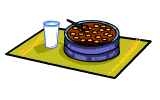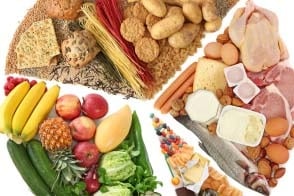A glassful of warm milk every morning, believe many people, is the perfect health food that keeps a person going for a long time. The three elements of nutrition, fat, protein and sugar (milk sugar or lactose), are all there in equal measures in milk.
It also contains the important minerals, calcium and phosphorus. Milk, being a food designed for a young animal, is thus, very suitable for young children. Moreover, no matter what you do with it, whether you pasteurise it, boil it, or condense it, you will destroy very few of its nutrients.

The Milk Express [Illustration by Shinod AP]
They argue that the ability to digest milk disappears for many people in late childhood. If they continue to use milk in their diet, they will develop stomach aches, diarrhoea and gas caused by the milk sugar (lactose). It is much healthier, say these dietitians, to replace milk and dairy products, with calcium-rich soya milk and other plant products.
But it’s a fact that few foods can match milk in its versatility of uses. From being the complete food for babies to the main ingredient in the making of pastries, yoghurt and cheeses and other high-calorie rich foods, milk reigns as the world’s favourite food. K.T. Achaya in the book Everyday Indian Processed Foods, has written about all that milk can do.
In India we use both cow milk (with about 4.5 per cent fat) and the richer buffalo milk (7 to 8 per cent). These days many people are switching to toned milk that comes to us in bottles and sachets, and which is a technologically standardised product.
Toned milk yields less cream and ghee than the other two as it is in diluted form. It is used in tea and coffee, for making curds and for use as baby feed, as it is easily digested in the baby’s stomach. Other forms of milk include milk powders, which is prepared by removing the 85 per cent water that milk contains. Baby food powder too is made similarly, only the fat and protein content are brought down to lower levels.
Cream is made of the fat of milk, that is separated in a cream separator, sterilized, homogenized, cooled and canned. The fat content is usually 20 per cent. Condensed milk, that most of us have loved to slurp and lick as children (and adults) is milk that is boiled down or condensed under vacuum to bring the water level down drastically. Extra sugar is added to it.
Khowa or mawa is evaporated milk, prepared by constantly stirring and heating milk to a doughy consistency in a pan. A dry khoa product called pindi, is used to make sweetmeats like barfi. A less dry khoa is used for making gulab jamun.
Then there is paneer or cottage cheese which is made when milk is heated to a high temperature, slowly stirred, citric acids or lime being added to it. The milk separates into whey and the paneer, which is used to make light sweets like rasogolla and sandesh.
Cheese, another milk product, is favoured worldwide as a delicacy. Fresh cream cheeses are skim milk curds drained, granulated or cubed, heated to firmness and coated with cream, like the Italian mozarella. Soft ripened cheeses, which ripen from the outside to the centre and have a soft crust, include Camembert, a French cheese.
Then there are the aged, hard, granular ripened and richly-flavoured cheeses like the cream coloured English cheddar and the strong Italian Parmesan, which is usually grated over spaghetti and pizzas.
Worried about the calorie content of these milk products? Switch to yogurt or dahi, a low-calorific alternative which is made by adding a little bit of dahi to boiled milk cooled to body temperature. The action of bacteria in the milk leads to the milk being fermented and the forming of curd in a few hours. Living bacteria are present in large amounts in dahi; when eaten they are supposed to aid food digestion.
A number of flavours and sweeteners are added to commercially-manufactured yoghurt, to widen its appeal, especially for children. Shrikhand, a delicacy in Gujarat, is white curd made from pasteurized skim milk to which is added sugar and powdered cardamom seeds.
Milk or cream is used to make the batter for pastries, sponge cakes and other creamy treats. It is again milk, that gives chocolate, especially milk and sweet chocolate, ice-creams and custards their unique rich flavour.
So go ahead and indulge your milk craving. Remember though, that moderation is the key.










